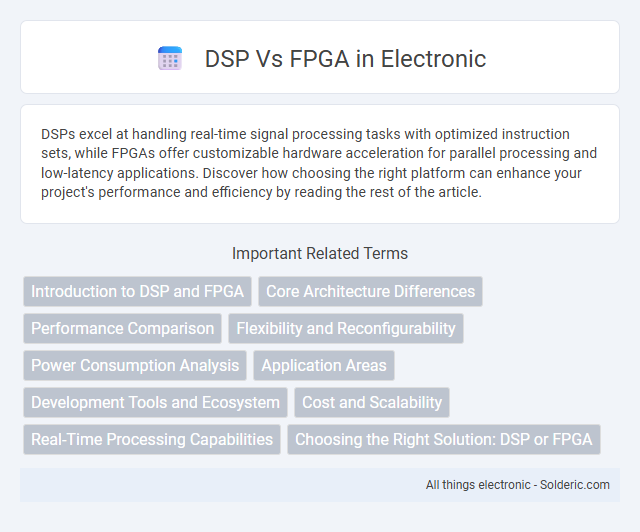DSPs excel at handling real-time signal processing tasks with optimized instruction sets, while FPGAs offer customizable hardware acceleration for parallel processing and low-latency applications. Discover how choosing the right platform can enhance your project's performance and efficiency by reading the rest of the article.
Comparison Table
| Feature | DSP (Digital Signal Processor) | FPGA (Field Programmable Gate Array) |
|---|---|---|
| Architecture | Specialized microprocessor optimized for signal processing tasks. | Reconfigurable hardware with programmable logic blocks. |
| Processing Speed | High speed for sequential arithmetic operations. | Parallel processing capabilities enable higher throughput. |
| Flexibility | Fixed architecture; software-programmable. | Highly flexible; hardware reconfigurable on the fly. |
| Power Consumption | Generally lower power for fixed algorithms. | Can be higher due to parallelism and reconfigurability. |
| Development Complexity | Easier; uses high-level languages like C/C++. | Complex; requires hardware description languages (VHDL/Verilog). |
| Use Cases | Audio, speech processing, real-time control systems. | Signal processing acceleration, custom hardware designs, prototyping. |
| Cost | Lower initial cost for mass production. | Higher upfront cost; cost-effective for low to medium volume. |
Introduction to DSP and FPGA
Digital Signal Processors (DSPs) are specialized microprocessors designed for efficient real-time processing of audio, video, and sensor data, optimized for calculations like Fourier transforms and filtering. Field-Programmable Gate Arrays (FPGAs) are customizable integrated circuits that allow hardware configuration to perform parallel processing tasks with high throughput and low latency. Understanding the fundamental architectures of DSPs and FPGAs helps you choose the best solution for applications demanding speed, flexibility, and precision in signal processing.
Core Architecture Differences
DSP cores are optimized for high-speed arithmetic operations with a fixed, pipelined architecture tailored for signal processing tasks, featuring specialized ALUs and MAC units. FPGA architecture relies on an array of configurable logic blocks interconnected by programmable routing, allowing for flexible, parallel processing tailored to specific applications. Understanding these core architecture differences helps you select the appropriate device based on performance needs and design complexity.
Performance Comparison
Digital Signal Processors (DSPs) excel in real-time signal processing with optimized instruction sets for arithmetic operations, delivering lower latency in fixed-point calculations. Field-Programmable Gate Arrays (FPGAs) offer unparalleled parallelism and customizable hardware pipelines, resulting in higher throughput for complex algorithms and applications requiring extensive data-level concurrency. Performance in tasks like filtering, FFT, and matrix multiplication typically favors FPGAs for their ability to process multiple streams simultaneously, while DSPs provide simpler development and better energy efficiency for sequential processing workloads.
Flexibility and Reconfigurability
DSPs offer high flexibility in handling a wide range of signal processing algorithms through programmable software environments. FPGAs provide superior reconfigurability by enabling hardware-level customization via programmable logic blocks, allowing tailored parallel processing architectures. This hardware modification capability grants FPGAs unmatched adaptability for evolving application requirements compared to the fixed architecture of DSPs.
Power Consumption Analysis
FPGA devices typically exhibit higher power consumption compared to DSPs due to their reconfigurable logic blocks and routing resources, which require continuous switching activity. DSP processors optimize power efficiency by leveraging specialized arithmetic units and streamlined architectures designed for signal processing tasks. Evaluating power consumption in your application depends on workload complexity and real-time requirements, where DSPs generally offer lower energy use for fixed-function processing, while FPGAs provide flexibility at the cost of increased power draw.
Application Areas
Digital Signal Processors (DSPs) excel in real-time audio, telecommunications, and image processing applications due to their specialized instruction sets and efficient handling of repetitive mathematical operations. Field-Programmable Gate Arrays (FPGAs) are preferred in high-throughput data processing, hardware prototyping, and custom signal processing systems, offering parallelism and hardware-level customization. Both DSPs and FPGAs play crucial roles in radar systems, medical imaging, and automotive driver assistance systems, where performance and flexibility requirements vary.
Development Tools and Ecosystem
DSP development tools primarily include specialized integrated development environments like Texas Instruments Code Composer Studio and analog Devices VisualDSP++, offering extensive libraries tailored for real-time signal processing algorithms. FPGA ecosystems feature platforms such as Xilinx Vivado and Intel Quartus, which support hardware description languages (HDLs) like VHDL and Verilog, enabling custom hardware acceleration and parallel processing capabilities. Your choice between DSP and FPGA should consider the maturity of toolchains, availability of IP cores, and community support, which significantly impact development efficiency and project scalability.
Cost and Scalability
DSPs (Digital Signal Processors) generally offer lower upfront costs and easier scalability for moderate signal processing tasks, making them ideal for budget-sensitive projects. FPGAs (Field-Programmable Gate Arrays) provide higher scalability and performance flexibility for complex, high-throughput applications but often come with increased development and hardware costs. Your choice depends on balancing cost constraints with the scalability needs of your specific signal processing workload.
Real-Time Processing Capabilities
DSPs excel in real-time processing for signal and image tasks due to their specialized architecture and instruction sets optimized for fast mathematical operations. FPGAs offer customizable parallel processing that enables ultra-low latency performance, ideal for applications demanding immediate data handling. Your choice depends on the trade-off between dedicated real-time algorithms versus flexible hardware-level concurrency.
Choosing the Right Solution: DSP or FPGA
Choosing between a Digital Signal Processor (DSP) and a Field-Programmable Gate Array (FPGA) depends on application-specific requirements such as processing speed, flexibility, and power consumption. DSPs excel in real-time signal processing tasks with optimized instruction sets and ease of programming, making them ideal for applications like audio processing and communications. FPGAs offer parallel processing capabilities and hardware-level customization, providing superior performance in high-throughput scenarios like image processing, encryption, and custom algorithm implementation.
DSP vs FPGA Infographic

 solderic.com
solderic.com